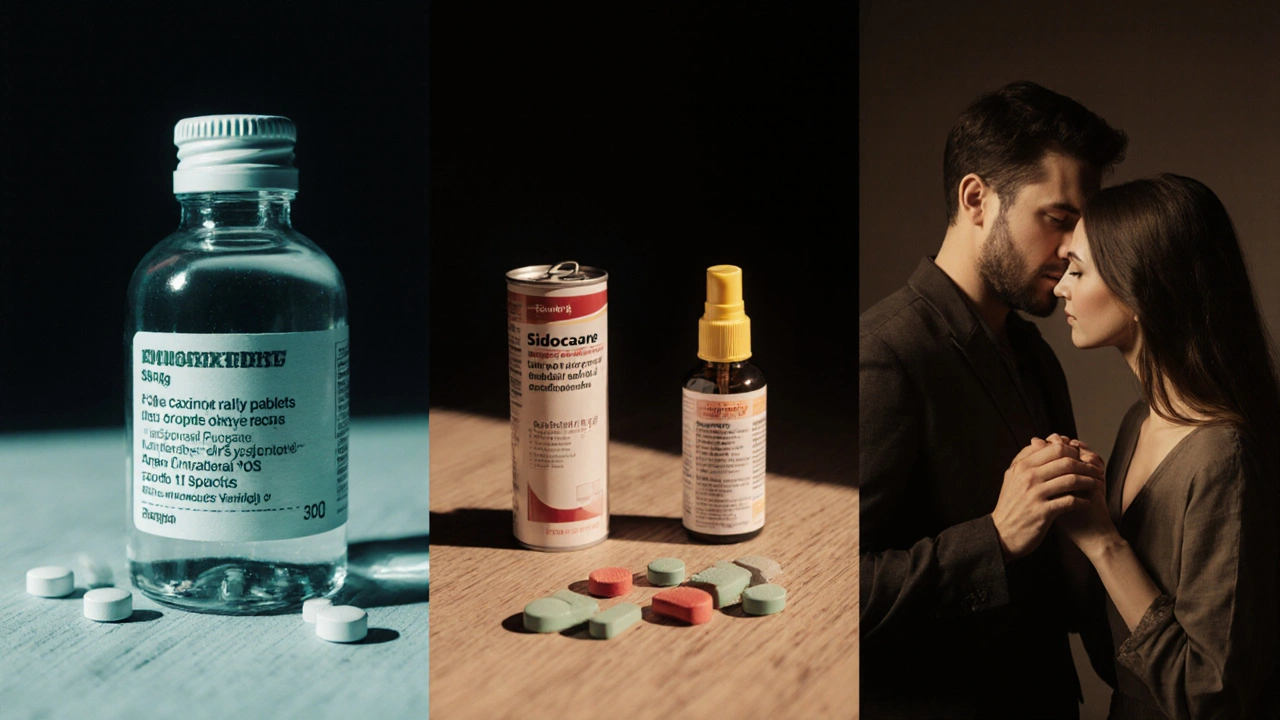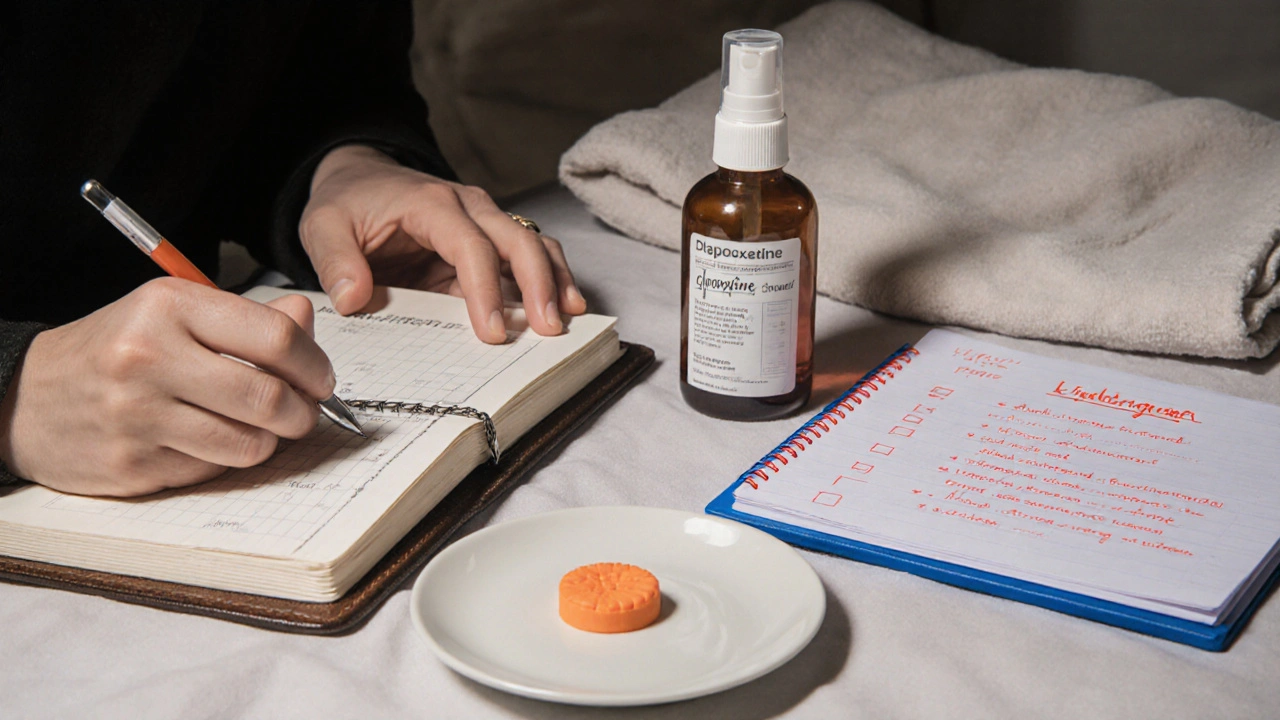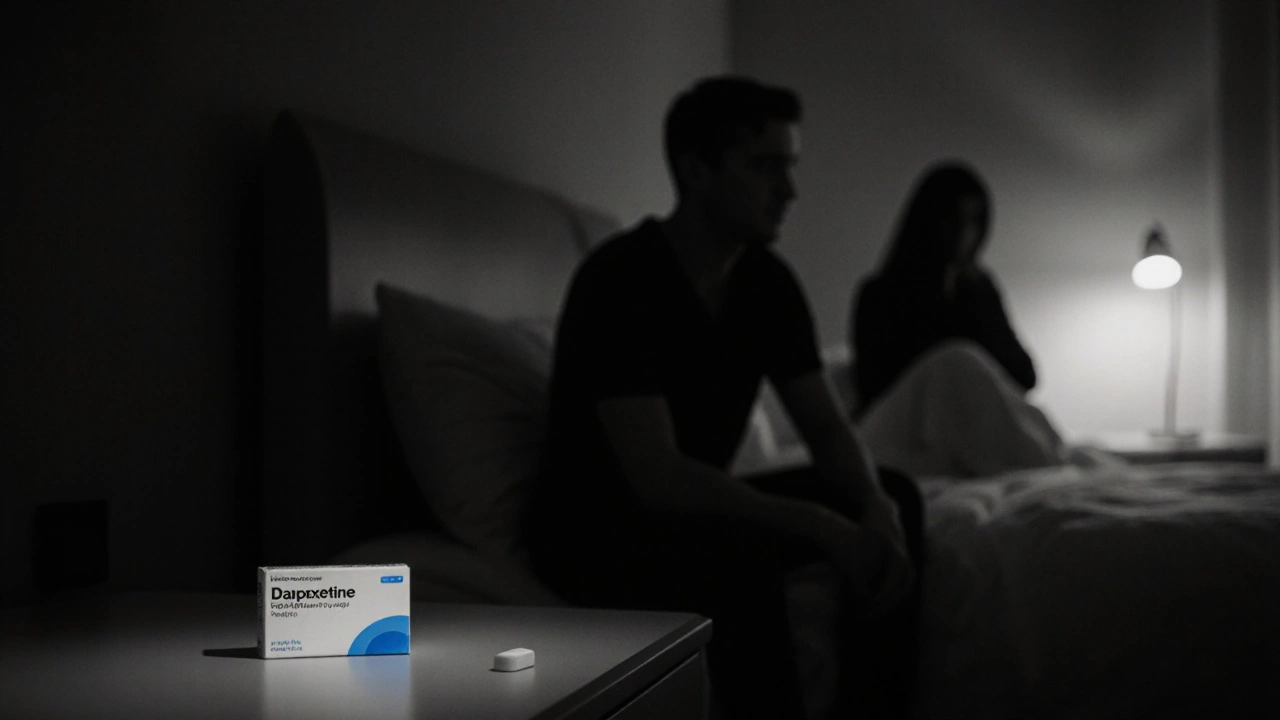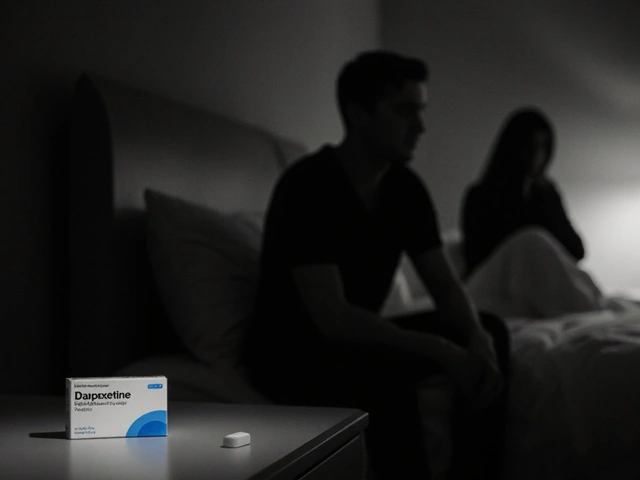Premature ejaculation (PE) affects up to 30% of men worldwide, creating frustration and anxiety in intimate relationships. Dapoxetine is a short‑acting selective serotonin reuptake inhibitor (SSRI) approved in many countries specifically for on‑demand use against PE. But is it the best choice? Below we break down how dapoxetine stacks up against other pharmacologic and non‑pharmacologic options, so you can decide which path fits your lifestyle and health profile.
Key Takeaways
- Dapoxetine works quickly (30‑60min) and is taken only before sex, unlike traditional daily SSRIs.
- Other oral SSRIs (paroxetine, sertraline, fluoxetine) are cheaper but require daily dosing and have more systemic side effects.
- Topical lidocaine sprays provide localized numbness with minimal systemic impact, but may reduce pleasure for both partners.
- PDE5 inhibitors such as sildenafil can improve ejaculatory control indirectly by enhancing erection quality, useful when ED co‑exists.
- Behavioral techniques (stop‑start, squeeze) are free and effective for many, though they demand practice and partner involvement.
Understanding Dapoxetine
Dapoxetine is a rapid‑acting SSRI designed for on‑demand use. It reaches peak plasma levels within an hour and clears from the body in about 20hours, allowing flexibility without daily medication. The typical dose is 30mg or 60mg taken 1-3hours before sexual activity. Clinical trials show a 30‑40% increase in intravaginal ejaculation latency time (IELT) compared with placebo.
Common side effects include nausea, dizziness, headache, and mild insomnia. Because it’s a short‑acting agent, these effects usually subside quickly. Dapoxetine is prescription‑only in most regions, though some countries allow limited over‑the‑counter sales.
Alternative Oral SSRIs
Traditional SSRIs such as Paroxetine, Sertraline and Fluoxetine have been used off‑label for PE for years. They increase serotonin levels more broadly and require daily dosing (typically 20‑50mg for paroxetine, 50‑100mg for sertraline, 20‑60mg for fluoxetine). Their onset of action can take 2‑4weeks, but once steady, IELT improvements of 2‑3minutes are common.
Side‑effect profiles are broader: weight gain, sexual dysfunction (e.g., reduced libido), and emotional blunting can be more pronounced. Because they stay in the system longer, interactions with other meds (e.g., anticoagulants) demand careful monitoring.
Topical Anesthetic Options
Products like Lidocaine spray or creams work by numbing penile skin, delaying the sensation that triggers ejaculation. Application is usually 10‑15minutes before intercourse. Doses vary: sprays deliver 10mg per actuation; creams are applied in a pea‑size amount.
Advantages include minimal systemic absorption and rapid reversibility. However, partner desensitization is a frequent complaint, and over‑use can cause skin irritation. Topicals do not address underlying psychological factors that often coexist with PE.

PDE5 Inhibitors and Combination Therapy
When erectile dysfunction (ED) accompanies PE, Sildenafil (or other PDE5 inhibitors) can indirectly help. By improving erection rigidity, men often report better control over ejaculation. Typical dose is 50‑100mg taken 30‑60minutes before sex.
Side effects include headache, flushing, and rare visual disturbances. Combining sildenafil with dapoxetine is off‑label but some clinicians prescribe it for patients with both ED and PE, monitoring for additive cardiovascular risks.
Behavioral and Psychological Strategies
Techniques such as the "stop‑start" method, the "squeeze" maneuver, and mindfulness‑based therapy target the neuro‑behavioral component of PE. They require consistent practice, often with a supportive partner, but they avoid medication side effects altogether.
Success rates in clinical settings range from 30‑60% improvement in IELT after 8‑12 weeks of guided practice. When combined with medication, behavioral methods can boost outcomes and potentially reduce the needed drug dose.
Side‑Effect and Safety Snapshot
| Option | Class | Typical Dose & Timing | Onset (minutes) | Duration (hours) | Key Efficacy (IELT ↑) | Common Side Effects | Prescription Status |
|---|---|---|---|---|---|---|---|
| Dapoxetine | Short‑acting SSRI | 30‑60mg, 1‑3h before sex | 30‑60 | ≈20 | +30‑40% | Nausea, dizziness, headache | Prescription |
| Paroxetine (daily) | SSRI | 20mg daily | ~1,440 (2‑4weeks) | 24‑48 | +50‑100% | Weight gain, sexual dysfunction, fatigue | Prescription |
| Lidocaine spray | Topical anesthetic | 1‑2 sprays, 10‑15min before | 10‑15 | ≈2‑3 | +10‑30% | Skin irritation, partner numbness | OTC in many markets |
| Sildenafil | PDE5 inhibitor | 50‑100mg, 30‑60min before | 30‑60 | ≈4‑6 | Indirect, +20‑40% when ED present | Headache, flushing, dyspepsia | Prescription (OTC in some regions) |
| Behavioral therapy | Psychological/technique | Weekly sessions + home practice | Varies (weeks to months) | Long‑term | +30‑60% (varies) | Time commitment, need for partner | No prescription |

Choosing the Right Option for You
Consider the following decision matrix:
- Urgency vs. Routine: If you need an on‑demand solution for occasional sex, dapoxetine or lidocaine spray fit best.
- Cost Sensitivity: Daily SSRIs are generally cheaper per month but require ongoing use.
- Side‑Effect Tolerance: Those prone to nausea may avoid dapoxetine; anyone worried about sexual desire loss may favor topical or behavioral routes.
- Co‑existing Conditions: If ED is present, a PDE5 inhibitor or combination therapy could kill two birds with one stone.
- Partner Involvement: Behavioral methods need active partner participation; discuss expectations early.
Always consult a qualified healthcare professional before starting any medication, especially if you take antidepressants, anticoagulants, or have cardiovascular disease.
Cost Overview (2025 US & AU Pricing)
Approximate monthly costs (rounded for ease):
- Dapoxetine: US$80‑$120; AU$90‑$130.
- Paroxetine: US$15‑$30; AU$20‑$35.
- Lidocaine spray: US$25‑$40 (single bottle lasts ~20 uses); AU$30‑$45.
- Sildenafil: US$10‑$25 per tablet; AU$12‑$28.
- Behavioral therapy: US$100‑$200 for a 6‑session package; AU$130‑$250.
Insurance coverage varies. In Australia, the Pharmaceutical Benefits Scheme (PBS) lists paroxetine but not dapoxetine, making the former more affordable for many.
Practical Tips for Effective Use
- Take dapoxetine with a light snack to lessen nausea.
- Don’t combine dapoxetine with other SSRIs or MAO inhibitors - risk of serotonin syndrome.
- If using lidocaine spray, wipe excess off before intercourse to avoid partner discomfort.
- Start behavioral exercises in a low‑pressure setting (e.g., solo practice) before involving a partner.
- Track your IELT in a simple journal to see real progress, regardless of the method you choose.
Frequently Asked Questions
Can I use dapoxetine together with a daily SSRI?
No. Combining two SSRIs can lead to serotonin syndrome, a potentially serious condition. If you’re already on a daily SSRI, discuss alternative PE treatments with your doctor.
How long does dapoxetine stay effective after a dose?
Peak effects appear within 30‑60minutes and last about 3‑4hours. The drug’s half‑life is roughly 20hours, so residual levels are minimal after a day.
Is lidocaine spray safe for frequent use?
It’s generally safe, but daily use can irritate the skin and reduce pleasure for both partners. Rotate with non‑topical methods if you notice numbness or discomfort.
Do PDE5 inhibitors treat the root cause of premature ejaculation?
No, they mainly improve erection quality. They can help men who ejaculate too quickly only when the rapid loss of erection contributes to the problem.
Which option is best for a man on a tight budget?
Daily paroxetine or fluoxetine is usually the most cost‑effective, especially if covered by insurance or national health schemes. Topical sprays are an affordable on‑demand alternative when the frequency is low.
Bottom line: dapoxetine alternatives span a spectrum from daily antidepressants to simple sprays and lifestyle techniques. Your choice should balance speed of action, side‑effect tolerance, cost, and whether you need a partner‑involved plan. Consulting a urologist or sexual health specialist will help tailor the best regimen for your unique situation.







Moritz Bender
October 15, 2025 AT 17:34Dapoxetine's pharmacokinetic profile is characterized by rapid absorption, reaching Cmax within 30‑60 minutes, and a relatively short elimination half‑life of ~20 hours, which underpins its on‑demand utility for premature ejaculation (PE).
Because it is a selective serotonin reuptake inhibitor (SSRI) with preferential affinity for the SERT transporter, it modulates serotonergic tone in the spinal ejaculatory centers without the cumulative serotonergic burden seen with daily SSRIs.
The drug's oral bioavailability is approximately 42 %, and food can modestly delay Tmax, so taking it with a light snack is advisable to mitigate nausea.
Clinical trials have consistently demonstrated a 30‑40 % increase in intravaginal ejaculation latency time (IELT) versus placebo, translating to an average gain of about 1‑2 minutes in real‑world use.
Side‑effect incidence is dose‑dependent: the 60 mg regimen raises the risk of dizziness and headache by ~12 % compared with the 30 mg dose.
Importantly, because dapoxetine clears from systemic circulation within a day, the residual serotonergic activity is minimal, reducing the likelihood of sexual dysfunction such as reduced libido that plagues chronic SSRI therapy.
From a pharmacodynamic perspective, dapoxetine's rapid onset aligns well with the temporal demands of sexual activity, making it a viable option for men who engage in intermittent intercourse rather than daily routine.
Cost considerations remain a barrier in many markets; US retail prices hover around $80‑$120 per month, which can be prohibitive without insurance coverage.
Insurance formularies often exclude dapoxetine because it is not listed under generic SSRIs, prompting some clinicians to recommend off‑label daily SSRIs as a cost‑effective alternative.
When evaluating drug–drug interactions, clinicians must screen for concomitant MAO inhibitors or other serotonergic agents to avoid serotonin syndrome.
Renal or hepatic impairment necessitates dose adjustment: a reduced 30 mg dose is recommended for patients with moderate hepatic dysfunction (Child‑Pugh B).
In practice, patient education on timing (1‑3 hours pre‑coitus) and adherence to dosing limits (no more than one dose per 24 hours) is essential to maximize efficacy and safety.
Comparative studies suggest that while daily paroxetine may yield a higher absolute IELT increase, dapoxetine offers superior flexibility and a more favorable side‑effect profile for many users 😊.
Nicole Hernandez
November 4, 2025 AT 09:34Thank you for the thorough breakdown; the emphasis on timing and metabolic considerations really clarifies how dapoxetine fits into a broader treatment algorithm.
I also appreciate the pragmatic note on insurance coverage, as financial feasibility often dictates patient adherence.
Balancing efficacy with side‑effect burden is key, and your insight into hepatic dose adjustments will be valuable for clinicians managing comorbidities.
florence tobiag
November 24, 2025 AT 01:34Dapoxetine? Really?!!! It's just another pharma‑pushed quick fix!!!
Everyone forgets the underlying psychogenic contributors-stress, performance anxiety, relationship dynamics- all ignored in your sterile table!!!
And the "short‑acting" label? That's a marketing ploy to make you think it's safe when it's just a serotonin‑spike pump that can trigger long‑term dysregulation!!!
Don't be fooled by the glossy charts-real relief comes from addressing the root causes, not from sprinkling more chemicals on the problem!!!